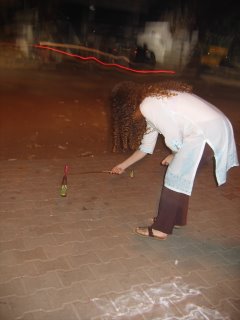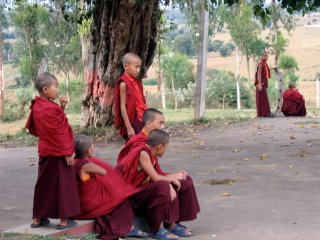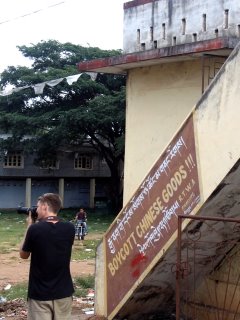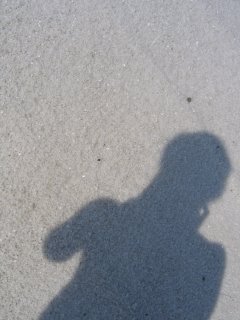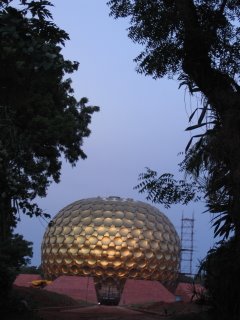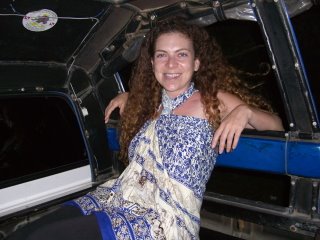On our fifth day in Coorg, Alex and I decided to go for a hike. It was hard to tear ourselves away from our books and balcony. I was cruising through a Carl Hiaasen; he was busy with Bill Bryson. From the villa's second-floor balcony we had views of dayglow-green rice paddies, papaya trees and mist-shrouded mountains. Dragonflies swirled all around. Coffee and tea came on trays. We didn't budge for hours at a time, though the occasional rainbow compelled us to reach for our cameras.

Coorg, a mountainous region in southwest Karnataka, is
coffee-growing country, which made the trip something of a pilgrimage for me. Alex, that heathen, turned his back on coffee several weeks ago. He agreed to Coorg anyway, lured by Lonely Planet's promise of "awesome trekking routes" and cooler weather.
Coorg recalls Costa Rica (lush forests, lousy roads) and California's wine valleys (sprawling estates, little to do but drink). It has a number of designated Lookout Points, at which taxi drivers pull over, point and announce, "lookout point," obliging passengers to snap a few photos. This is like designating Good Paintings in a Van Gogh exhibit; everywhere you look, a masterpiece. Coffee and cardamom plants blanket the landscape, shaded by trees cloaked in pepper vines. Elephants amble through forests of sandalwood and teak. Overhead: oranges, guavas, jackfruit, bananas and coconuts, to name a few.

Coorg was our "something adventurous." We'd ruled out trekking in the Himalayas (too far) and scuba diving off the Andaman Islands (too rainy). Coorg was relatively close, a six-hour drive from Bangalore, and its monsoon season, purportedly over.
A long stop in
Bylakuppe kept us from trekking on day 1. Rain scuttled our plans on day 2. On the third day, we took breakfast on the balcony outside our room at Capitol Village, a plantation-cum-resort just outside the Coorg capital of Madikeri. (In recent years, overproduction of coffee and other commodities has made tourism more lucrative than tilling the land.)
The plantation owner pulled up a chair, as he did every morning. Ganesh plays the part to the hilt, roaming his estate in safari hat, oval shades and ascot.
"What is your plan for today?"
Alex and I looked at each other as if he'd asked, "What do you plan to do with the rest of your lives?" Finish breakfast. That was our plan. Maybe finish our books. Go for a trek.
At the mention of trekking, Ganesh shook his head and curled his lips. "Leeches," he grumbled.
I'd never seen a leech. I knew a little about them, which was a little more than I knew about
geckos, thanks to my favorite movie. In "Stand by Me," a 1986 coming-of-age flick starring my first love, River Phoenix, four boys emerge from a muddy pond covered in leeches. The scrawniest of them faints after discovering an engorged leech in his underwear. "Stand By Me" remained my favorite movie long after my subscriptions to "Tiger Beat" and "BOP" lapsed, though I stopped admitting it at some point and claimed to adore "Out of Africa."
I thought of River, rest his soul, when Ganesh said "leeches."
Daily rains had soaked the trails, leaving them slippery and leech-infested, Ganesh told us. Trekking was possible, but only with proper rain gear. The only rain gear I'd brought was an umbrella.
"What do you suggest we do?" I asked.
Ganesh thought for a while. (As previously mentioned, there's little to do in Coorg. Attractions are few, a fact underscored by the existence of Lookout Points. The temples are humble affairs. Shopping, unless you're in the market for coffee or cardamom by the kilo, is nonexistent. As for the restaurant scene, well, there's a reason why Capitol Village serves three meals a day to its guests.)
Ganesh summoned his assistant, who summoned a driver, who took us to a dam more than an hour away.
When Ganesh said dam, I thought Hoover. I expected an engineering marvel or dizzying view. Harangi Dam is neither of these. It's a ho-hum structure surrounded by manicured lawns studded with concrete benches. The guidebooks say it's a good picnic spot. I thought it had all the appeal of a suburban office park. Cameras weren't allowed, which was just as well.
Then the driver took us to Dubare Elephant Training camp, where we petted the pachyderms and watched them eat their evening snack.
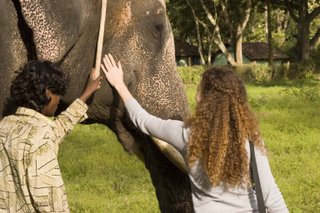
On day 4 we left Capitol Village and moved to a smaller, more remote lodge. Palace Estate is near the base of Thadiyendamol, the highest peak in Coorg. We parked ourselves on the balcony and prayed for sun.
Day 5: gorgeous. A perfect day for trekking. Also a perfect day for reading and lazing about. We were shamed into choosing the former when our host inquired, "What is your plan for today?" (Apparently, Coorg's plantation owners took the same hospitality courses.)
We packed our cameras, bug spray and a light lunch. I traded the flimsy sandals I'd been wearing all week for a pair with traction soles and lots of Velcro. I left the umbrella.
Thadiyendamol rises to 5,730 feet. The one-way climb from Palace Estate takes 2 to 3 1/2 hours, depending on your pace. We made good time as I scrambled to keep up with my leggy companion.
We were two-thirds of the way there when it started to drizzle. Drizzle turned to downpour, and Alex decided we should turn back. I wanted to reach the top -- I wanted
something to write home about -- but I relented.
We splashed our way down the mountain. The rocky trail had turned to river.
River.
"Stand by Me."
Leeches.
They clung to my feet and ankles. A few were trapped in Velcro. They were small and slippery, and getting hold of them was like spearing grape tomatoes with a fork. I stopped half a dozen times to pinch and pull them away. (Alright, alright. Alex did most of the pinching and pulling. I flailed my arms and squealed encouragement.)
Lest anyone question the title of this blog, I offer exhibit #1.


